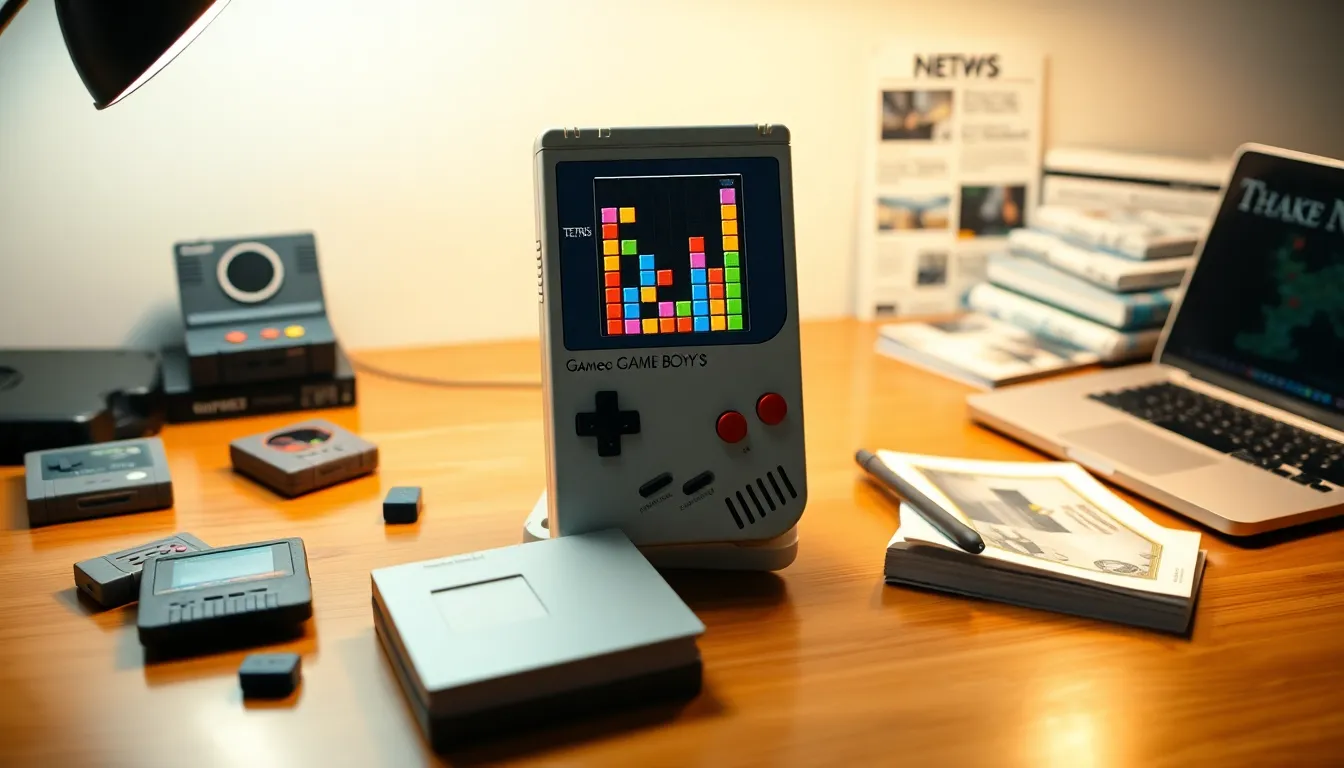Table of Contents
ToggleWhen gamers think of timeless classics, Game Boy Tetris jumps to the forefront like a well-placed Tetrimino. Released in 1989, this deceptively simple puzzle game has captured the hearts and minds of players for decades. Who knew that stacking blocks could become such a worldwide phenomenon? Grab your Game Boy, dust off those cartridges, and let’s journey through Tetris’ legacy.
The Origins of Tetris and Its Impact on Gaming

Tetris was born in the Soviet Union in 1984, thanks to the brilliant mind of Alexey Pajitnov. Designed as an experiment, it quickly morphed into a gaming staple. Initially released on the Electronika 60 computer, the game’s simple yet addictive gameplay caught on like wildfire. As players slid and rotated blocks to create complete lines, they found themselves engrossed, often losing track of time. The concept of matching blocks to clear lines was revolutionary, paving the way for an entire genre of puzzle games. Its impact is undeniable, today’s puzzle games owe a significant debt to Tetris.
The game had a turbulent journey, navigating through various platforms and even facing legal battles around copyrights. But, its charm won through: thanks to the public’s insatiable appetite for puzzle-solving, Tetris wasn’t just a fleeting fad, it was a defining moment in gaming history.
The Birth of Game Boy and its Influence on Tetris
In 1989, Nintendo introduced the Game Boy, the handheld console that would change the gaming landscape forever. This petite device allowed players to carry their gaming sessions in their pockets, ushering in a new era of on-the-go entertainment. With Tetris as its flagship title, the Game Boy became a must-have for every gaming enthusiast.
Tetris, with its compelling gameplay and simplicity, was the perfect match for the Game Boy’s capabilities. Portable gaming was still in its infancy, and Tetris provided players with quick, engaging sessions that were easy to return to anytime. The two became intertwined, and the Game Boy was instrumental in Tetris’ global popularity. Nintendo’s decision to bundle Tetris with the Game Boy was genius, contributing heavily to the console’s success.
Gameplay Mechanics: How Tetris Redefined Puzzle Games
Tetris introduced gamers to sheet music for their fingers, each move creating a rhythm orchestrated by falling Tetriminos. The rules are simple: players rotate and line up differently shaped blocks to clear rows. As levels progress, the speed increases, building a nerve-wracking challenge that keeps players on their toes. Little did Pajitnov know, he had created a game that would redefine the puzzle genre.
The addictive gameplay is a blend of strategy and quick reflexes. Think of Tetris as a dance where players must keep in sync with falling pieces. Each decision matters, and with every line cleared, a rush of satisfaction follows. The feeling of a well-timed Tetris, a complete stack clearing, yields a high that few games can replicate.
Other puzzle games today, from Candy Crush to Bejeweled, have built on Tetris’ format but rarely capture its raw, unfiltered simplicity. The community-driven competition and leaderboards introduced a level of engagement not previously seen in puzzle games: this sparked the creation of global tournaments, showcasing how a simple concept could evolve into a worldwide phenomenon.
Cultural Impact and Legacy of Game Boy Tetris
Tetris transcended gaming. Its influence carved out a niche in popular culture, permeating various forms of media. The iconic theme music alone has been sampled and covered numerous times. From TV shows to movies, Tetris’ catchy tune evokes nostalgia for many who played it during childhood.
The game has found its way into academic discussions, with researchers studying its cognitive benefits and effects on mental agility. Tetris Effect, coined from the phenomenon where players’ experiences in the game bleed into their daily lives, has led to intriguing studies on its psychological impact.
Over the years, Tetris has inspired a thriving community, which includes game designers, artists, and musicians. Online competitions and speedruns boost its presence, and conventions now host Tetris tournaments, honoring its roots while embracing its evolution.
Tips and Strategies for Mastering Game Boy Tetris
Every Tetris master has a few tricks up their sleeve. To outpace opponents and reach new levels, players can benefit from practicing specific strategies. One useful tip? Learn how to recognize Tetrimino shapes quickly. Instead of waiting for pieces to descend, anticipate and move them into position preemptively.
Consider mastering the ‘T-Spin’ technique, where players can use the T-shaped Tetrimino strategically, this can help clear lines in tricky situations and rack up points. Another vital strategy is maintaining a ‘well’, keeping a single column clear for long pieces. Mastering the fundamentals like stacking and maintaining a solid foundation can lead to success.
Finally, always keep an eye on the next piece displayed on-screen: this foresight can make all the difference in high-paced gameplay.
The Future of Tetris: How It Continues to Evolve
Even though its age, Tetris continues to evolve, adapting to new technologies and gaming trends. Modern iterations come with fresh gameplay modes, multiplayer options, and cross-platform availability, inviting a new generation of players into the fray. Mobile apps, including TETRIS® Blitz, added twists with time limits and power-ups, keeping the core gameplay intact while enhancing the user experience.
Also, VR and AR technologies are beginning to explore Tetris in mind-bending ways. From Tetris Effect: Connected, which invites immersive environments to Tetris 99, where players compete against 99 others in real-time, the future looks promising. These advancements ensure that Tetris remains relevant, breathing new life into a timeless classic.




